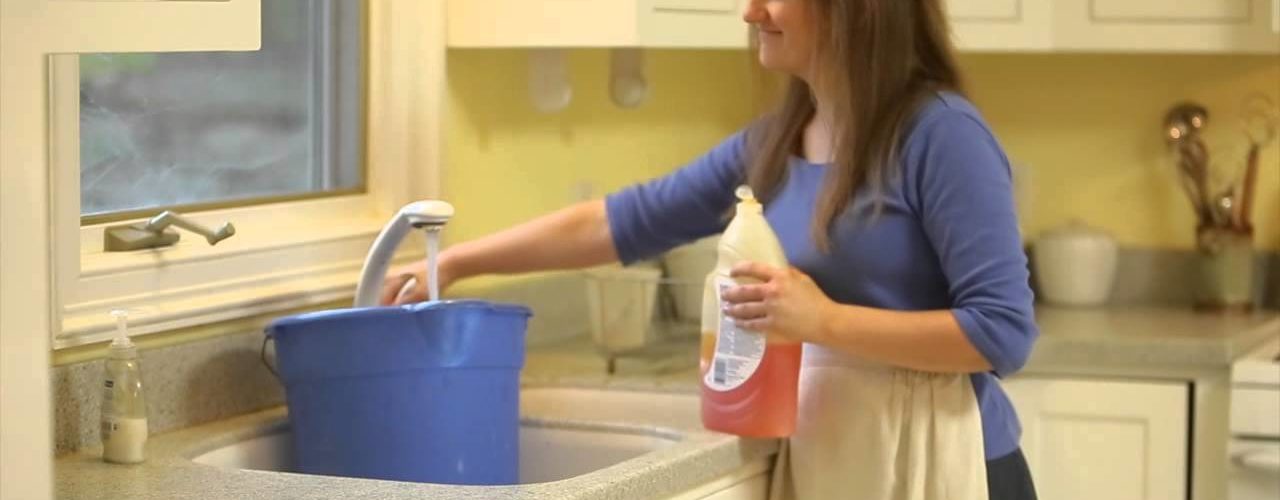Cleaning a kitchen is serious business; many harmful germs and bacteria develop in this food-friendly room of the home. Also many pests such as rats, cockroaches and worms often make their way in. Kitchen cleaning is more than spraying chemicals and scrubbing. Food should also be properly stored and food storage compartments should be regularly cleaned. Here is a helpful guide list to assist in a thorough kitchen cleaning:
Contents
 Start From The Top
Start From The Top
Without an exhaust fan or window to minimize moisture from cooking on the stove, the ceilings become grimy. Using a sponge squeegee or mop to clean it is advised. This is a non-abrasive mixture to use on all kitchen surfaces for cleaning: 1 tablespoon of laundry soap, 1 tablespoon of TSP powder and one-half gallon of hot water. For tough grime, Simple Green is a good cleaning chemical (for durable surfaces only). After the ceiling has been cleaned, wipe down the outer doors of the cabinets. Remove dishes from cabinets, two or three cabinets at one time and place the dishes in the dishwasher (or wash them by hand, if desired). Wipe out the shelves well; this mixture of soap, TSP and water will remove any accumulated grime easily. Remember to change the water and make a new batch of cleaning solution after 2-3 cabinets have been cleaned.
 Wipe Down Walls And Clean Appliances
Wipe Down Walls And Clean Appliances
Walls should be wiped down thoroughly using the previously mentioned cleaning solution recipe. Each appliance in the kitchen should also be thoroughly cleaned. For those who are unfamiliar with correct cleaning tips, here is a helpful website offering instructions for cleaning all types of kitchen appliances: How To Clean Stuff.
 Organize And Throw Away
Organize And Throw Away
Food items should be reviewed; anything past the expiration date should be discarded, especially refrigerated items. Watch for cupboard items which are powdered substances and not airtight. For example if a flour bag is rolled up and clamped shut with a clothespin, this is a potential hazard for worm development. Worms are found in dry substances such as oatmeal, cornmeal, flour, sugar, baking powder and some spices if they are not properly sealed. Flour, sugar and other dry substances may be stored in freezer storage bags with a zip seam closure or put in airtight canisters. When in doubt about what constitutes “well sealed” consider any container water would easily leak from, such as a paper flour bag, as unsafe. Labeling all freezer bags containing frozen meat or vegetables is also recommended.
 Clean The Windows And The Curtains
Clean The Windows And The Curtains
If curtains are new, they may be easily vacuumed on a low setting with a brush. If this is not available, simply taking them down and shaking them out thoroughly outdoors is equally as effective. Delicate curtains should be hand washed once per year; soaking them for a few hours first in a mild detergent with lukewarm water is advised. While the curtains are down, the windows should be cleaned. Using ammonia and water or a glass cleaning chemical is the best solution. Windows should be cleaned with a cotton washcloth or smooth rag; never with a paper towel.
 Finishing Up
Finishing Up
After all the dishes have been put away in the clean cupboards and the appliances, walls, ceilings and windows are all clean, the counters and sink should be cleaned thoroughly with the above mentioned cleaning solution recipe of TSP and detergent; counter-top decorations, accessories and small appliances should all be cleaned thoroughly as well. Lastly the floor should be swept and scrubbed or mopped. Setting roach and ant traps in the back of cupboard corners and below the sink is also highly advised.


 Start From The Top
Start From The Top
